It’s easier than ever to take your health in your own hands thanks to the wide availability of over-the-counter (OTC) devices and tools. Handy health-monitoring smartwatches, powerful massage therapy devices, and even the best treadmills are purchasable at retail stores. This advancement of readily available technology has improved the lives of many in the areas of weight loss, physical recovery, and even hearing.
The best hearing aids were previously only available through doctor prescriptions. However, on October 17, 2022, the Food and Drug Administration (FDA) made a ruling permitting the sale of OTC hearing aids. (1) Since then, the best OTC hearing aids have gained popularity to the point where several retail stores have added a designated area for the devices to their sales floor.
It’s only natural that the purchase and interest in OTC hearing aids have increased, especially because elderly populations and lifespans are increasing. (3) The FDA’s ruling opened the floodgates for manufacturers to produce a multitude of OTC hearing aids. Our team of experts and consumers meticulously tested over 30 OTC hearing aids using over 20 parameters to find the best hearing aids on the market.
Best OTC hearing aids overall
The Jabra Enhance 300 stands out as our top pick after meticulous testing. It’s pricey for an OTC hearing aid, but its features—such as hands-free calling, Bluetooth streaming, noise reduction, and Smart Start—make it a good option for seamlessly staying connected to who and what you love.
Our picks for the best OTC hearing aids
- Best overall: Jabra Enhance Select 300
- Best inexpensive: Audien Atom Pro 2
- Best invisible fit: Eargo 7
- Best remote customer service: MDHearing Volt
- Most user-friendly: Lexie Lumen
- Best Bluetooth:GoHearing Go Ultra
Compare OTC hearing aids

|
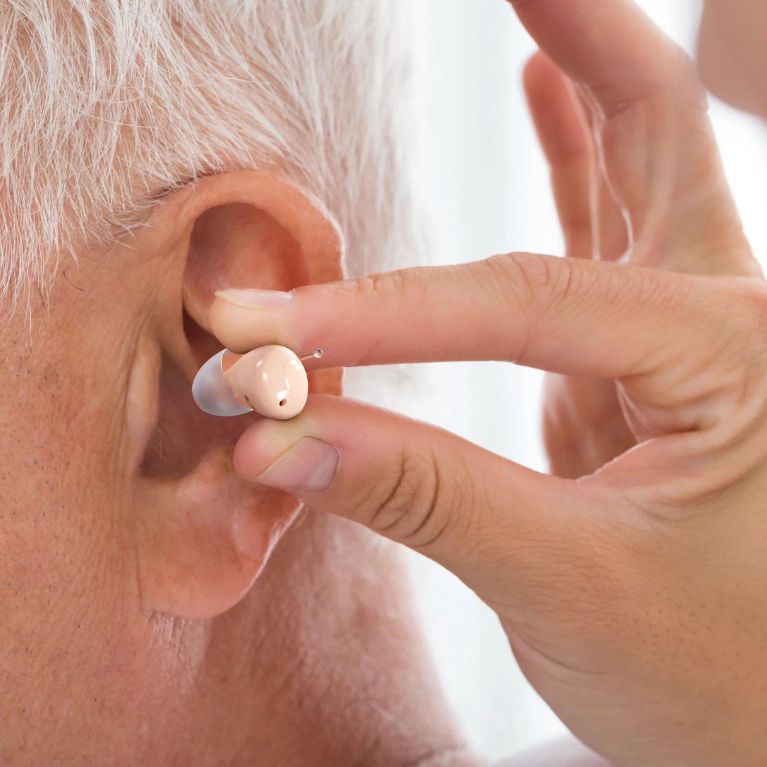
|

|
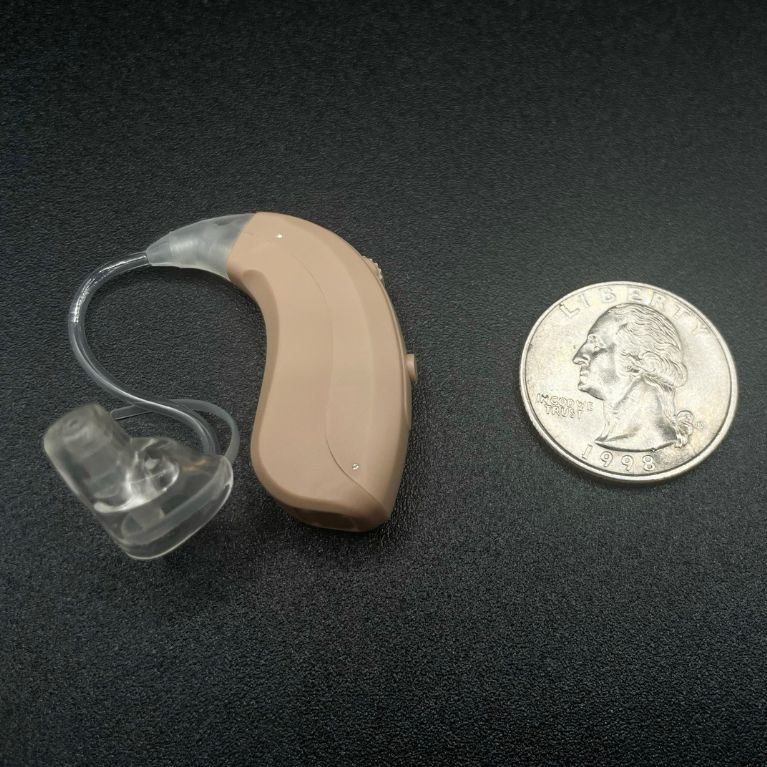
|
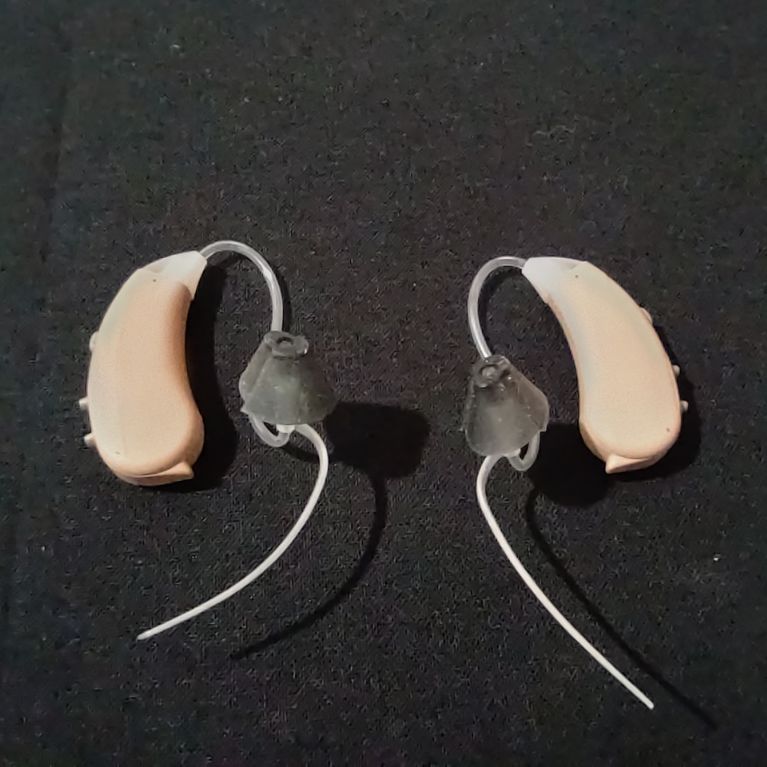
|

|
|
| Jabra Enhance Select 300 | Audien Atom Pro 2 | Eargo 7 | MDHearing Volt | Lexie Lumen | GoHearing Go Ultra | |
| Rating | ||||||
| Price | $1,495-$1,695 | $289 | $2,550 | $397 | $799 | $499 |
| Type | Behind-the-ear (BTE) | In-the-ear (ITE) | ITE | ITE | Receiver-in-canal (RIC) | BTE |
| Degree of hearing loss | Moderate | Mild | Mild to moderate | Moderate | Mild to moderate | Mild to moderate |
| Battery type | Rechargeable | Rechargeable | Rechargeable | Rechargeable | Disposable | Rechargeable |
Best overall OTC hearing aid: Jabra Enhance
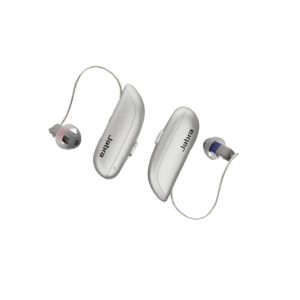

Key product features
What you should know
The Jabra Enhance Select 300 is a powerful hearing aid with a smart start feature that prevents unwanted feedback. It stands out with its Bluetooth capabilities, noise reduction, sound processing, and comfort.
- Our product testers appreciated that the Jabra Enhance Select 300 was packaged with an in-depth user manual, information cards, extra tips, and a charging cord.
- It is expensive for an OTC option, but it boasts a quality comparable to prescription hearing aids and is perfect for mild to moderate hearing loss.
- Its Smart Start feature, sound quality, and ease of use make it great for senior citizens.
Why we like Jabra Enhance 300 as the best overall OTC hearing aids
Jabra is a company that specializes in audio equipment and is renowned for its headphone products. As such, it’s no wonder that its headphones’ remarkable quality and innovative technology are experienced in the Jabra Enhance Select 300.
We like the Jabra Enhance Select 300 because it’s a standout hearing aid for performance and features. These hearing aids block out unwanted background noise while spotlighting speech through its sound processing and noise-reduction technology. Also, many states require a testing period for hearing aids. (4) The Jabra Enhance Select 300 goes well beyond the requirements—just 30 days—with a 100-day testing period.
The Jabra Enhance Select 300’s sound processing allows the device to cover all manner of noise levels. This means it’s useful for users who are likely to be in different environments. Users can enjoy a fulfilling listening experience during quiet conversations with loved ones or even complex listening situations such as restaurants and theme parks.
Additionally, these hearing aids are well-designed to handle an active lifestyle, since they’re inconspicuous and discreet. Moreover, they’re remarkably comfortable, to the extent that one tester thought they lost the device while it was in their ear.
“Comfort with hearing aids is all about how they fit your ears and how they feel in terms of sensitivity. Give yourself time to get used to them, and if they still bother you or are uncomfortable, talk to your audiologist about getting some adjustments.”
Dr. Raj Dasgupta, MD, FACP, FCCP, FAASM, Fortune Recommends Medical Advisor
Several of our testers praised the Jabra’s Smart Start feature, which delays the device from turning on after its removal from the charging case. This prevents any whistling or inconvenient sounds.
One standout feature is the Bluetooth connection, which allows users to stream music, TV, and phone calls directly into the hearing aids. However, testers found the streaming quality a little fuzzy.
Finally, we like that these hearing aids come bundled with bonus domes (earpieces), an in-depth user manual, and information cards, which act as a simpler setup experience from the manual.
Check out our full Jabra hearing aids review for more information about this brand’s hearing aid options.
What customers are saying
Because the Jabra Enhance Select 300 is not sold in retail stores, it’s difficult to find online commentary from customers. We combed the r/HearingAids subreddit for the opinions of real users.
User “Adventerous-Ad-1133” raved, “I am unbelievably happy with Jabra device and how easy it is to set up with my Google Pixel 4 XL running Android 13. All the features are working to my expectations.”
“So far I am very happy with my 300s,” writes Reddit user “Jasesdad.” “I’m using the restaurant mode for watching TV since it will suppress noise behind and [on the] sides of me and focuses on front audio…The 300s definitely do a much better job at suppressing loud noises.”
Specs
| Type | BTE |
| Degree of hearing loss | Moderate |
| Battery type | Rechargeable |
| Price | $1,495-$1,695 |
| Warranty | Three years |
Best inexpensive OTC hearing aid: Audien Atom Pro 2
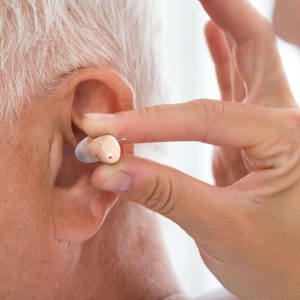

Key product features
What you should know
The Audien Atom Pro 2 is notable for its compact size and performance. It’s an inexpensive device for the features it offers, such as noise cancellation, all-day battery life, and a two-in-one charging case.
- Our product testers noted that changing settings within the ears requires pressing the on-device buttons. This is a problem because they may push the device deeper into the ear.
- It’s best for users with mild hearing loss.
- Testers complained noticed whistling and feedback.
Why we like Audien Atom Pro 2 as the best inexpensive OTC hearing aid
Audien Hearing, or simply Audien, has a reputation for producing over-the-counter hearing aids at affordable prices. Its Atom 2 hearing aids cost only $189, while the Atom Pro 2 are just $100 more at $289. This low price gives more people access to better hearing, and studies show that good hearing improves physical and mental health. (5)
The Atom Pro 2’s features and performance are comparable to those of more expensive brands. The device’s A2™ chip offers competitive-level sound clarity and advanced noise cancellation to maintain clear sounds. However, testers noted frequent whistling and feedback noise when putting the device on.
“Whistling in hearing aids can be caused by a number of factors,” begins Dr Raj. “It can take your ears a few weeks to get used to your aids and during the adjustment period some people may experience a ringing or whistling noise. Other factors such as earwax buildup, having the volume too high, and incorrect fitting hearing aids can cause frequent feedback noises. Speak with your audiologist if you are experiencing feedback while using hearing aids.”
The button on the back of the devices allows users to select one of four available modes and three power levels. However, one of our testers noted that changing the modes or volume settings while the device is in the ear may push the device deeper into the ear.
Fortunately, each piece of the Atom Pro 2 has a “pull line” that allows the device to be easily removed from inside the ear. Our testers agree that the device is fairly discrete and comfortable in the ear.
Users can enjoy up to 24 hours of battery life. Additionally, these hearing aids can reach a full battery in 4-6 hours.
The two-in-one charging case has a built-in UV light that sanitizes and removes up to 99.9% of germs. It’s Audien’s smallest case and fits in the pocket just like an AirPods case.The Audien Atom Pro 2 is a budget-friendly hearing aid for those looking for an easy, affordable hearing solution. Users have access to a lifetime of Audien customer service and support despite the lack of audiologist support that comes with traditional prescription hearing aids.
For more insights on this brand, check out our full Audien hearing aids review.
What customers are saying
Amazon users generally have positive things to say about the Audien Atom Pro 2’s performance. However, hearing feedback was a recurring issue in a few reviews.
Amazon reviewer, Kevin, notes that the Atom Pro 2 “works well for me.” He prefers them to his previous hearing aids, which caused discomfort and were less useful: “I needed a solution but didn’t have $5,000-$6,000 for a new set. So I thought I’d try these. I’ve worn them a few days, and so far, they help me hear better.”
However, Kevin did note one concern: “They’re more comfortable than my old hearing aids, but they’ve had one noticeable issue: For me, they generate some feedback. I hear this feedback when the aids move around—start to pull out, or when something moves my ear canal, like chewing or blowing my nose. I found it helped to switch to the smaller dome.”
Specs
| Type | ITE |
| Degree of hearing loss | Mild |
| Battery type | Rechargeable |
| Price | $289 |
| Warranty | $4/month protection plan |
Best invisible fit OTC hearing aid: Eargo 7
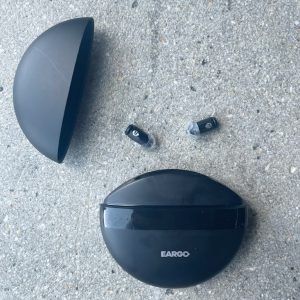

Key product features
What you should know
The Eargo 7 hearing aids are renowned for their discrete design, making them virtually invisible. These hearing solutions provide noise reduction, Sound Adjust+, and up to 16 hours of listening on a single charge.
- Our product testers had difficulty with the Eargo 7’s 15-to-20-minute initial setup. One tester had a problem pairing the hearing aids to the app, but the remote Eargo audiologist was able to assist the tester.
- The $2,550 price tag is justified by performance and customization options but may not be reasonable for potentially “tinny” and “echoey” sounds.
- They are capable of handling mild and moderate hearing loss, but our testers didn’t like the confusing instructions and app dependency. These factors and size may make it unsuitable for seniors.
Why we like Eargo 7 as the best invisible fit OTC hearing aid
The Eargo 7 hearing aids are a modern solution to the age-old problem of hearing loss. These are not only small, with a sleek, all-black design, but they’re also practically invisible hearing aids when worn. This makes them an appealing choice for those who might be embarrassed about their reliance on a hearing aid or even worried about the device not matching an outfit or skin tone.
Another quality of the Eargo 7 is its ability to perform well in a variety of environments despite its small frame. It has Sound Adjust+, a feature of its clarity mode that allows users to hear more crisp speech through different soundscapes. These hearing aids are also self-fitting, with one product tester noting that the self-fitting process takes about 15 minutes.
Additionally, the flexible petal tips of the dome are removable, and each of the two tips provides a separate listening experience. The closed tip helps to seal off the ear to reduce sound leakage and background noise. The open petal tip grants a more natural listening experience yet also offers sound clarity. A couple of our product testers noted that the sound quality isn’t as good as other hearing aids and may even be “tinny” and “echoey.”
The Eargo 7 is generally a user-friendly device. Its downloadable app has a plethora of customizable features, such as programs, individual listening parameters, and volume. However, the app requires a 20-minute download, rendering the Eargo 7 unusable until the download is complete. Also, the volume cannot be changed on the device, only on the app, which was frustrating for one product tester.
Some testers had trouble understanding the manual, using the app, plus putting in and taking the Eargo 7 out of the ear. The Eargo 7 is still a viable choice, even for seniors, if the user can handle any setbacks.
If this isn’t the right pick for you, visit our best invisible hearing aids roundup for more great options. Or, see our full Eargo hearing aids review to learn more.
What customers are saying
The Eargo 7’s reviews are overwhelmingly positive. Most users boast of its performance prowess, especially when compared to other devices.
“I love my Eargos and wouldn’t know what to do without them. They are amazing; nothing comes close to Eargo. Please don’t mess with lesser products; it’s a waste of your time and money.”
David L., Verified Amazon Buyer
Amazon reviewer Andrew K. had the complete opposite experience, as explained in his 1-star review: “Don’t waste your money on these. These are not designed for people with moderate hearing loss. Good luck with programming them. It keeps running into error after error when trying to program them. I’ll stick with my behind-the-ear hearing aids.”
Andrew’s programming issue coincides with some of our product testers’ reviews. Still, many Amazon reviewers were “totally satisfied” with their Eargo 7 hearing aids.
Specs
| Type | ITE |
| Degree of hearing loss | Mild to Moderate |
| Battery type | Rechargeable |
| Price | $2,550 |
| Warranty | Two years |
Best simple OTC hearing aid: MDHearing Volt
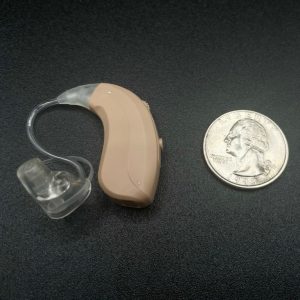

Key product features
What you should know
The MDHearing Volt offers a unique blend of simple controls and advanced technology. The features are packaged in a user-friendly design. Some testers had issues with the initial setup, but most had no problems.
- Our product testers appreciated the Quick Start Guide’s clear setup instructions, yet some had issues with the initial process.
- The MDHearing Volt hearing aids are $799 when bought separately, but the price shifts to $397 when both earpieces are bought as a pair.
- Product testers had nothing to say about poor performance issues. There were no comments regarding any feedback, whistling, or “tinny” audio.
Why we like MDHearing Volt as the best simple OTC hearing aid
Simple and effective is the phrase best suited to describe the MDHearing Volts. None of our product testers complained about any feedback, whistling sounds, or “tinny” or “echoey” audio.
The MDHearing Volt outperforms similar hearing aids at its sale/bundle price point. Its most noticeable audio-related features are its advanced noise reduction and feedback cancellation.
The Volt’s design makes it virtually invisible. It’s a behind-the-ear hearing aid connected to an in-ear dome by a clear tube. The dome has a comfort tip for all-day comfort, and a product tester stated that it’s comfortable to wear. “Invisible hearing aids can be just as effective as others on the market, but it’s important to speak with your doctor about the correct option for you,” adds Dr. Raj.
There’s no app, as the four modes can be cycled through on the device itself. Our testers noted that its features are very basic, and those who want a more customizable experience should look into other devices.
The Volt comes with a handy Quick Start Guide, three card instructions, cleaning tools, and a charging case. The case stops charging the hearing aids when they’re fully powered up, preserving the rechargeable hearing aids’ battery longevity. Moreover, the earpieces snap into the case, which will display a green light if the earpieces are placed correctly.
The MDHearing Volt can cost upwards of $1,699, with either earpiece selling for $799 separately. Such a price per earpiece may be a potential issue for interested parties with unilateral hearing. (11) However, the price is lowered to about $397 when both earpieces are bundled together. This means purchasers are potentially getting quality devices for a fraction of the cost.
The MDHearing Volt’s strengths are simplicity and performance. Those who need a great-performing, inexpensive option without all the excess bells and whistles will enjoy the Volt.
For more insights, check out our complete MDHearing review.
What customers are saying
Customers find that these hearing aids are worth their higher price tag.
Amazon user Kevin K. compares the MDHearing Volts to a more expensive previous pair in his four-star review. He wrote, “I am very old, so everything is more difficult. [I was] also born with nerve deafness and a tiny canal on the left side. MD hearing aids are $5,000 less than the big box store [hearing aids] I tried in 2010. I can wear them all day and hear much better. MD has been very helpful with the very few problems I had. Mostly my fault too. You may spend more, but you won’t get more elsewhere.”
However, Amazon user “RPreston513” didn’t have the same amount of success with the Volt and “had to send them back.” They write: “I only had these for about a month before the left one stopped working unexpectedly. While they worked, they were decent hearing aids, especially for the price. Since I’m going to the trouble of sending them back, I’ve opted for a refund instead of a replacement. I think this time, I’ll pay a little more and get a hearing aid that has an app for my phone and some type of Bluetooth compatibility.”
Specs
| Type | BTE |
| Degree of hearing loss | Moderate |
| Battery type | Rechargeable |
| Price | $397 |
| Warranty | One year |
Best user-friendly OTC hearing aid: Lexie Lumen
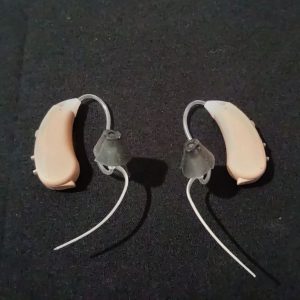

Key product features
What you should know
The Lexie Lumen champions simple, user-friendly design, and its app allows for easy program customization and access to support.
- Our product testers appreciated the device and app’s simplicity and ease of use.
- These hearing aids have a lower mid-range price point for OTC hearing aids at $799.
- They utilize self-fitting technology to set up a personal hearing profile. The Lumen is heavily app-dependent, so this essential feature and more will not work without it.
Why we like Lexie Lumen as the best user-friendly OTC hearing aid
Nearly everything about the Lexie Lumen is user-friendly, especially its features and app. However, users must have a smartphone for its initial setup. Having a Bluetooth-enabled smartphone is necessary since it unlocks the Lumen’s functions for a seamless user experience.
Volume settings and mode changes are adjustable through the app as well as on the Lumen earpieces. The Lexie app gives users access to Lexie Experts™, who provide personalized support seven days a week. One product tester liked that the Lexie app has a rewards feature that incentivizes users to wear their Lumens.
The Lumen’s six environment settings give users optimal sound experience in any situation. The earpieces also have dual microphones for the directionality feature, which allows for better pinpointing and clarity of the sound users want to hear. All sounds that enter the Lumen are enhanced through digital sound processing.
The Lumen has nifty voice alerts, which our product testers listed as a notable feature. These alerts use human speech to make users aware of which modes they switched to and when the Lumen’s battery is low.
For more insights on this brand, check out our full Lexie hearing aids review.
What customers are saying
Customers on Amazon love how easy it is to set up the Lexie Lumen. Many of their reviews agreed that the Lumen is better than their previous, more premium hearing aids.
“I’ve had $6k hearing aids and $100 amplifiers. The sound quality is not like the $6k hearing aids, but being able to hear better is priceless without the high cost. I have no trouble changing batteries, and the Bluetooth to the app works every time.”
Wendy W., Verified Amazon Buyer
Amazon user Bonnie shared similar sentiments in her own 5-star review: “These are much better than $4,000 ones I previously had. All adjustments are made on your phone.”
Some users, like Dot H., were dissatisfied with the battery life. “The batteries are only lasting about two-and-a-half days, and because of this, I would never buy them again and actually wish I hadn’t bought them this time.”
Specs
| Type | RIC |
| Degree of hearing loss | Mild to moderate |
| Battery type | Disposable |
| Price | $799 |
| Warranty | One year |
Best Bluetooth OTC hearing aid: GoHearing Go Ultra
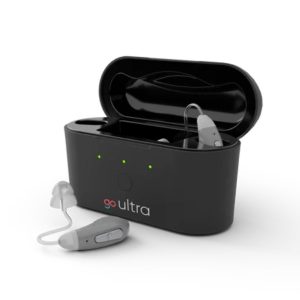

Key product features
What you should know
The GoHearing Go Ultra is our top pick for seamlessly connecting to devices through Bluetooth. Additional features like noise cancelation, digital sound processing, and a Memory Recall function are all packed inside this affordable device.
- Our product testers enjoyed streaming phones, tablets, and television through Bluetooth. They were surprised that the Go Ultra could not connect to the computer for increased versatility.
- The Bluetooth features and general quality are not standard compared to other hearing aids around its price point of $499.
- Perfect for users with mild to moderate hearing loss who don’t want to constantly switch between devices that require their auditory attention.
Why we like GoHearing Go Ultra as the best Bluetooth OTC hearing aid
The GoHearing Go Ultra hearing aid is an excellent choice for those who want a seamless auditory experience as they go from place to place. Convenience is the name of the game, and the GoHearing Go Ultra is a top player with features and technology.
These hearing aids can be connected to modern televisions, smartphones, and tablets with a Bluetooth connection. Not only does the Go Ultra allow users to hear music in a natural manner, but its ability to pair with smartphones and tablets allows direct streaming through music apps. Music can be beneficial to an individual’s well-being, (6) especially as hearing loss can lead to loneliness, depression, and anxiety. (12)
Our product testers were surprised that the hearing aids do not connect to computers. This means that users cannot stream Zoom calls, videos, music, and games on computers. One product tester noted that Bluetooth streaming drains the battery and decreases operation time to about eight hours.
Of course, the GoHearing Go Ultra has features that are more typical of hearing aids, including noise reduction and digital sound processing. Moreover, there are four preset hearing programs that allow users to personalize their listening experience.
The Go Ultra comes packaged with several slim tubes and tips for the device to fit better, plus a measuring tool for easy sizing. Quite a few of our product testers had issues switching out the slim tubes. One tester was concerned that potential users would fear breaking their devices because of the force required to remove the slim tubes.
There isn’t an app for these hearing aids, so users have to change programming modes and volume settings using the buttons on the device. However, the device has a memory recall function that remembers the last settings the user was using.
The GoHearing Go Ultra is an affordable option for hearing aids with Bluetooth connectivity. Very few hearing aids at this price point utilize Bluetooth for entertainment purposes, and many more don’t offer it at all.
Check out the best Bluetooth hearing aids to find more options for you.
What customers are saying
Customers on Amazon generally enjoy the Go Ultra’s Bluetooth capabilities.
“I can connect these to my TV when I don’t want to disturb my suitemates. When walking, I can easily toggle between hearing mode and audiobooks on my phone. [I] easily connected to my iPad and my Android phone too. I’ve tried a number of devices. These are awesome.”
Nesje, Verified Amazon Buyer
An Amazon verified purchaser named “Dice” wasn’t too pleased, writing: “It’s a decent-performing product, but the battery life leaves a lot to be desired.” This coincides with our product tester noting that using the Bluetooth feature will drain the battery.
Specs
| Type | BTE |
| Degree of hearing loss | Mild to moderate |
| Battery type | Rechargeable |
| Price | $499 |
| Warranty | One year |
How we test hearing aids
Purchasing a hearing aid isn’t just about amplifying sound—it’s about enhancing quality of life. We aim to match readers with the hearing aid that best fits their needs. We thoroughly examine each hearing aid we recommend through firsthand testing, evaluating it based on its performance, value, customer service, and other criteria. Read our full hearing aid testing methodology for more information on our testing process.
Performance (auditory effectiveness)—40%
A hearing aid’s most important factor is how well it performs. We analyze how effectively the devices amplify sound, improve speech intelligibility, and provide a natural listening experience.
- Sound quality
- Noise reduction
- Feedback control
- Programmability and connectivity
Features—30%
Additional features can enhance a user’s hearing experience. We aim to highlight the capabilities that matter most for comfort, satisfaction, and willingness to use the device consistently.
- Durability
- Battery options
- Hearing loss range
- Wireless connectivity
- Water resistance
- Safety features
Value—20%
We delve into the hearing aid’s overall cost-effectiveness, from its upfront price to its potential for longevity. Value isn’t just price but includes durability, maintenance costs, and more.
- Insurance coverage
- Financing options
Customer experience—10%
The customer’s experience makes the difference between a good hearing aid and a great one. We incorporate the following factors into our evaluation to demonstrate a full picture of the service each hearing aid provides.
- Shipping
- Warranty
- Customer support
What are OTC hearing aids?
Over-the-counter hearing aids are medical devices designed to help adults ages 18 and older with mild to moderate hearing loss better listen, communicate, and participate fully in daily activities. They aren’t suitable for children or individuals with severe hearing loss, who benefit from more in-depth care provided by a medical provider or licensed hearing professional.
Consumers can purchase these devices in retail stores and online without visiting a doctor or audiologist. They don’t need to be professionally fitted or programmed—you can do it all yourself from the comfort of your home. However, many audiology offices sell OTC hearing aids if you prefer to buy them through your hearing professional, who can also perform an in-depth hearing test and general guidance regarding your hearing aids.
While a hearing test isn’t required, many OTC hearing aid retailers offer free online hearing tests to help you better understand your hearing health and be paired with the device that best suits your needs. However, these tests cannot diagnose underlying conditions and should not replace a thorough hearing examination conducted by a licensed audiologist.
Gaining FDA approval in 2022, OTC hearing aids are a relatively newer alternative to prescription hearing aids. As the number of older adults and those experiencing hearing loss continues to grow, it has become a public health priority to make hearing aids more affordable and accessible within the U.S., and these over-the-counter devices are a significant step in the right direction. (9, 10)
How do OTC hearing aids work?
OTC hearing aids are typically worn behind or within the ear canal and work through air conduction. This process uses microphones to amplify sound and direct it into the ear canal, stimulating the eardrum. From there, it moves through three tiny bones in the middle ear until it reaches the inner ear. It’s then turned into electrical signals sent to the brain and processed to allow us to hear the sound. (1)
Experiencing sound feedback is a common concern among hearing aid users. While the reason behind this is a bit complex, the short explanation is that the amplified sound from the hearing aid is being returned to the microphone. This often happens due to poor hearing aid fit, excess ear wax, a damaged device, or setting the hearing aid volume too high (11). The good news is that many of these causes are fixable. Moreover, many manufacturers have developed and equipped hearing aids with technology that can detect feedback and cancel it before it’s noticeable to the wearer.
Pros and cons of OTC hearing aids
OTC hearing aids present an exciting opportunity as a convenient and affordable solution for many of the close to 30 million adults living with hearing loss in the U.S. (1). However, among the various benefits they offer, there are some drawbacks worth considering before purchasing these devices. Below, we’ll take a closer look at the pros and cons you may experience with OTC hearing aids.
Pros
- Cost: Buyers can save considerably more money when purchasing OTC hearing aids than prescription options. Our evaluation found that most OTC devices range from less than $200 to $3,000. In comparison, the average cost of prescription hearing aids is over $4,000, according to a recent HearingTracker survey. (12) Besides the cost of the actual device, you’ll also pay less for medical visits since you can purchase the OTC hearing aids without seeing a doctor or audiologist or having to complete an in-office hearing evaluation.
- Accessibility: Offering hearing aids over the counter significantly increases the convenience and availability of these devices. Without needing to undergo hearing tests, clinical office visits, and in-depth evaluations, many users save substantial time and effort to access hearing aids. This nearly immediate availability is a considerable improvement compared to the average of seven to 10 years many individuals wait to seek professional hearing support because of how time-consuming it can be, concerns with cost, or fear of stigma. (13)
- Ease of use: During our evaluation, we found that many OTC hearing aids are ready for use with their self-fitting design and customizable features. The manufacturers include comprehensive, easy-to-follow instructions that direct users to adjust directly on the device through a smartphone app or computer. Our testers found many devices were easy to set up and included quick access to customer support to help you get the correct fit, configure settings, make adjustments, and troubleshoot any challenges.
- Regulated by the FDA: As an approved medical device, the FDA ensures OTC hearing aids are safe and effective. (1) This includes standards for packaging labels that can help buyers understand what these devices are, who they’re intended for, and pertinent information and warnings for when you should see a doctor.
Cons
- Not suitable for all levels of hearing impairment: It’s critical to remember that OTC hearing aids are designed for individuals with mild to moderate hearing loss. Individuals experiencing severe hearing loss should seek a qualified hearing specialist to ensure adequate care.
- Lack of in-person support: While most OTC hearing aid manufacturers offer remote support, some users may miss receiving in-person support from hearing specialists. If you feel less confident fitting and adjusting the devices, this may be a significant drawback.
- Fewer features: OTC hearing aids continue to advance in their technological features. However, prescription options can generally offer a more personalized hearing solution with more customization, functionality, and advanced features.
- Not available for children and adolescents: OTC hearing aids are not approved for individuals under 18. Because these devices are self-programmable, they carry the risk that a user could set the volume too high and potentially further damage the child’s hearing. On the other hand, if they’re programmed to be too quiet, the child may miss out on the support they need to help with speech, language development, educational success, and social interaction. (14)
Who should use OTC hearing aids?
OTC hearing aids are best suited for adults over 18 with mild to moderate hearing loss. The most accurate way to know if you fall within this designated hearing impairment range is to schedule a visit with your doctor or qualified hearing specialist for a complete evaluation and in-office hearing test. However, those steps are not required to get hearing aids. Instead, you may start with a free online hearing test or by simply watching for signs that commonly indicate hearing difficulties, such as:
- Frequently asking others to repeat what they’ve said or to speak more slowly or clearly
- Turning up the volume on your TV, phone, or radio to louder levels than others or what you’ve previously needed to hear it well
- Misunderstanding words because you can’t hear all letter sounds—most often consonants
- Finding yourself avoiding social situations
- Experiencing tinnitus or ringing in your ears
It should be emphasized that OTC hearing aids are not the appropriate solution for all individuals and hearing-related challenges. Children and those experiencing severe hearing loss should consult a medical professional to ensure they get appropriate care. Moreover, you should seek immediate care if you experience any of the following:
- Sudden hearing loss in one or both ears
- Hearing has significantly declined within the last few days or weeks
- Hearing loss with discharge from your ear or accompanied by an earache
Related: The Best Hearing Aids for Tinnitus
How much do OTC hearing aids cost?
One of the most remarkable benefits of OTC hearing aids is their ability to offer a lower-cost solution to hearing loss. The price of each device varies considerably based on design, brand, features, and overall quality. However, the cost generally falls between $189 to $2,950, with some OTC hearing aids priced as low as $99. Fortunately, it’s unlikely that you’ll find an OTC hearing aid that costs over $3,300. (12)
How to save money on OTC hearing aids
Building on the lower price of OTC hearing aids, you can further lessen the impact on your wallet by employing some simple yet effective strategies.
Compare prices: Spending a little extra time shopping can ensure you get the best deal on your devices. While some models are only sold directly by the manufacturer, others can be found in large box stores, retail pharmacies, and online marketplaces. Depending on where you buy it, you can find the exact device available at a cheaper price.
Watch for discounts or sales: You may be able to capitalize on lower prices during promotional events and seasonal sales. Additionally, many retailers offer discounts on opened boxes and refurbished products. Just be sure those previously owned devices come with a solid warranty to help give you peace of mind when buying them.
Only get what you need: While getting a device with all the latest cutting-edge technology may seem exciting, it can also quickly drive the price up. Consider which features are most critical to your hearing needs and accept leaving behind any you don’t need or want.
Opt into a payment plan: During our evaluation, we found that many OTC hearing aid retailers offer affordable financing options that allow you to pay over time to help reduce the upfront cost.
Make use of special benefits: Some individuals, including veterans, some government employees, and those eligible through additional hearing-related programs and non-profit organizations, may qualify for free or reduced-cost hearing aids, hearing tests, and other supplies.
How to choose the best OTC hearing aids for you
The availability of OTC hearing aids continues to expand, with more and more online and in-store retailers, pharmacies, and hearing specialists offering these devices. As the options expand and the technology evolves, how do you know which device will work best for you?
We’ve outlined some pivotal elements you may consider as you navigate the OTC hearing aid marketplace to help you decide which devices may best fulfill your needs.
Types of OTC hearing aids
Hearing aids don’t come in a one-size-fits-all design. You can choose various styles to find which best suits your comfort level, hearing needs, and desire for discretion. (6)
- Behind-the-ear (BTE): BTE styles are likely the first image that comes to mind when you think of hearing aids. They hook over the ear and rest behind it, then a tube or wire connects the amplifying component behind the ear to a dome that sits in the ear, which delivers the sound to the ear canal. These models are often less expensive but are typically more noticeable than other styles.
- In-the-ear: Closely resembling Bluetooth earbuds, in-the-ear hearing aids fit entirely inside the ear’s outer portion. Despite their small size, they can offer advanced features, including Bluetooth, noise reduction, and directional microphones. You can expect to pay more for this style, but it can be worth it if you value the more discreet nature.
- In-the-canal: As the name suggests, these devices fit into the ear canal. They’re available in two styles—in-the-canal (ITC) and completely-in-canal (CIC). These hearing aids have the benefit of being nearly invisible to others, which can appeal to users who want to keep their hearing loss private. Because of their smaller size, they can be more difficult to handle and replace batteries for those with dexterity issues. Plus, their location makes them more susceptible to earwax buildup.
Comfort and fit
Because these devices become a part of your everyday life, it’s pivotal that they fit well and feel comfortable. The dome—an acrylic or silicone piece connected to the hearing aid’s receiver tube—often comes in various styles and sizes to help accommodate differences in individual ear canals and device configurations.
Some OTC hearing aids may come with only one or two dome options, while others bundle multiple styles and sizes. If you’re new to hearing aids or unsure which dome will best suit you, we recommend selecting a brand and model that allows you to test various options to help ensure you find the best fit.
Many OTC hearing aid manufacturers offer remote customer support that you can reach out to for guidance on finding the right fit. While this is often done over the phone or through online chat, some companies, like Jabra, also offer video calls with a member of its audiology team. If you prefer in-person support, you can often visit your medical provider or hearing professional for general guidance on fit and programming, even without prescription hearing aids. We suggest calling your provider’s office first to understand what level of care they can provide and the cost of the office visit.
Customization
OTC hearing aids come with varying levels of customization depending on whether they’re self-fitting devices or pre-programmed.
Self-fitting hearing aids typically offer a more personalized experience. During the initial setup, you can fine-tune these devices to more precisely meet your unique hearing needs, such as zoning in on the ideal sound amplification level and frequencies you tend to have the most difficulty hearing. With this greater level of customization typically comes a higher price. The setup process may also feel more challenging to those less comfortable with technology.
Alternatively, preset hearing aids are ready to use right out of the box. They generally come equipped with multiple pre-programmed settings and different volume levels based on your degree of hearing loss.
Features and capabilities
As you browse the range of models available, you’ll notice that some OTC hearing aids stick to the basics of sound amplification while others come with more bells and whistles. Many models offer noise cancellation, Bluetooth capabilities, adaptive sound, and water and dust protection. Before purchasing any devices, consider your comfort level with technology and which features are your highest priority. If you’re like us, you won’t want to pay a higher price for advanced features you don’t need or know how to use.
Battery type and life
The battery is the device’s powerhouse and vital when evaluating OTC hearing aids. Some come with rechargeable batteries, while others utilize disposable ones, each with its benefits and drawbacks.
While rechargeable batteries can offer convenience with fewer battery replacements, they typically need to be recharged at least once per day, and using additional features, like Bluetooth connectivity, often drains them faster. For example, the GoHearing Go Ultra batteries typically hold a charge for 20 hours, but battery life is reduced to about eight hours when using Bluetooth consistently. However, opting for a model with a portable charging case can help you fully charge your hearing aids within two and a half to three hours to help limit disruptions. Even better, some offer a quick-charge option that gives you between six to 15 hours of battery use after just 30 minutes to one hour of charge time, depending on the brand you choose.
Conversely, disposable batteries offer a longer battery life, lasting several days to a few weeks at a time. By keeping extra batteries on hand, users can quickly replace them at a moment’s notice so they don’t have to go extended periods without the help of their hearing aids. Unfortunately, the small size of these batteries may make them harder to handle for individuals with limited dexterity.
Customer support
Ideally, buying your OTC hearing aids, unboxing them, and using them for years to come would all go off without a hitch. Unfortunately, as we’ve all experienced at one time or another, that’s not always the case when buying electronic devices. Choosing a brand that offers an easy-to-contact customer support team can help ensure a smooth, stress-free experience should any issues arise.
Trial period and return policy
Determining whether OTC hearing aids will work well for you can take some time, especially when you’re considering all of the elements we’ve already discussed. Moreover, it often takes several weeks to adjust to a new set of hearing aids. (15) That’s why it’s vital to look for brands offering a testing period and return policy that allows ample time to determine if the hearing aids fit well and help improve your hearing. Fortunately, all brands on our list come with a 45-day trial period, except the Jabra Enhance, which offers a more generous 100-day trial.
Potential side effects of OTC hearing aids
Fortunately, OTC hearing aids are generally low-risk. However, they do carry a short list of common, but usually mild side effects you may experience when using these devices.
- Headaches: Your brain will go through an adjustment period as it gets used to hearing new sounds that it hasn’t heard for a long time. This can feel overwhelming and lead to headaches or migraines. While everyone responds differently, typically these symptoms clear up within a few days. It may help to start by wearing your hearing aids for only a few hours and working up to a full day.
- Sore ears: As you get used to having this new device on or in your ear, you can expect to be more aware of it at first. However, this awareness shouldn’t be accompanied by soreness. Any pain you experience indicates your device doesn’t fit properly. You can try different size domes, contact the brand’s customer service team for help, or visit your audiologist for help getting the right fit.
- Ear wax buildup: Wearing ear molds all day can prevent ear wax from leaving your ears as it normally would. 16 This buildup of wax can block sound, create whistling feedback, and interfere with the hearing aid’s proper functioning. To help prevent wax buildup, you should consistently clean your hearing aids, according to the manufacturer’s instructions.
- Itching or irritation: Anytime you introduce a new device to your skin, you risk experiencing a reaction that may cause itching or irritation. If you’re allergic or sensitive to the device material, you may need to opt for a different brand or model. Earwax buildup can be another common culprit for itching, so proper cleaning is critical.
- Feedback: Some users sometimes notice screeching or whistling when wearing OTC hearing aids. While it may be partly due to the device quality, it’s often due to a poor fit, ear wax buildup, or the amplification being set too loud. (9)
Because you’re fitting and setting up OTC hearing aids yourself, it’s worth considering whether some side effects may be due to a device that doesn’t fit properly or isn’t programmed correctly. If the side effects continue, consider contacting customer support or scheduling a visit with your doctor or audiologist, who can help provide guidance on proper fit and programming.
FAQs
Are OTC hearing aids as good as prescription?
OTC hearing aids are generally as good as prescription hearing aids when dealing with mild and moderate hearing loss. However, they are not suitable for severe and profound hearing loss and will not work as effectively as prescription hearing aids for these conditions.
“While OTC aids are more affordable, prescription ones usually offer more personalized features and performance, though they’re pricier and require regular check-ins with a hearing specialist.”
-Dr. Raj Dasgupta, MD, FACP, FCCP, FAASM, Fortune Recommends Medical Advisor
Related: How Do Hearing Aids Work?
What’s the difference between OTC hearing aids and traditional hearing aids?
The main differences between OTC and traditional hearing aids are price, condition compatibility, and fit. OTC hearing aids cost less, are compatible with mild to moderate hearing loss, and are fitted by the user with pre-packaged tubes and domes. Traditional hearing aids are more expensive, are compatible with mild, moderate, severe, and profound hearing loss, and are professionally custom fit to a user’s ear and condition.
Does Medicare or Medicaid cover hearing aids?
Original Medicare does not cover hearing aids, so those who need hearing aids will have to purchase the devices on their own. (7) However, those with Medicare Advantage Plans (Part C) might be covered. Medicaid may cover hearing aids, but it depends on a variety of factors, such as the individual’s residing state. (8)
Alternatively, qualifying veterans can receive hearing aids through Veteran Affairs. (9) A few insurance plans and non-profit organizations cover hearing aids. (10)
It’s important to contact your plans and programs for more information about hearing aid coverage and support.
Who is selling OTC hearing aids?
OTC hearing aids are available in retail and big-box stores (like Best Buy, Walmart, CVS), online marketplaces (Amazon), and through a hearing aid manufacturer’s website.
Be aware that purchasing hearing aids from online marketplaces may cause issues with the manufacturers’ warranty. Some reviewers made complaints about receiving used or refurbished hearing aids.
Are OTC hearing aids just amplifiers?
At the core of their functionality, hearing aids work by amplifying sound, but there’s more to them than that. Instead of simply making sounds louder, they enhance them using a combination of signal processing and directional microphones that help reduce unwanted noise and improve a user’s ability to hear sounds with clarity. (21) Moreover, they are customizable for frequency, pitch, size, and fit to help suit the specific needs of each individual.
Are OTC hearing aids returnable?
While it’s not one of the sale conditions required by the FDA regulations, many OTC hearing aids are returnable. However, the exact return policy varies by retailer, with some offering more extended time periods than others. Because it can take time to determine which hearing aids are right for you, the return policy should be a critical element of your buying process. Selecting a brand that offers a minimum of 45 days for a trial period should give you ample time to test and adjust to the hearing aids to understand if they’re the best fit for you.
How long do OTC hearing aids last?
During our research, we found that most manufacturers state hearing aids typically last between five to seven years. Caring for your hearing aids through proper cleaning, storage, and battery replacement can help prolong their life and ensure they continue to function well for the duration of their lifespan.
Are there small and discrete OTC hearing aids?
Recognizing that hearing loss can feel like a personal, private matter to many consumers, some manufacturers offer virtually invisible OTC hearing aid styles. While you can find small over-the-ear options, users typically report that in-the-canal hearing aids provide the most discreet wearability. If you want to keep a low profile regarding your hearing health, check out our roundup of the best invisible hearing aids to help find a sensible option that works well for you.
What is the number one rated OTC hearing aid?
Based on our testing and research, we found that Jabra Enhance is the best OTC hearing aid on the market. It distinguishes itself with its user-friendly design that offers exceptional comfort, superb sound quality, and additional features. With one of the most generous trial periods at 100 days, Jabra allows users ample time to ensure they adjust well to the Enhance hearing aids and feel confident they’re the best fit.
Our experts
Dr. Raj Dasgupta, MD, FACP, FCCP, FAASM
Quadruple-board certified in pulmonary, sleep, internal, and critical care medicine. An active clinical researcher, Dr. Raj currently practices at the University of Southern California, where he’s been awarded the Excellence in Teaching award six years in a row. He’s also an associate professor of clinical medicine, assistant program director of the internal medicine residency program, and the associate program director of the sleep medicine fellowship at USC.
Krista Manning
Krista Manning is an accomplished medical copy editor and fact-checker who stands out in the pharmaceutical, health, and wellness domains. With a meticulous eye for detail and a command of medical language, Krista ensures the accuracy and clarity of content. Beyond her professional expertise, Krista is an advocate for mental health awareness. Recognizing the crucial intersection of psychological and physical well-being, she actively contributes to projects that promote mental health awareness within the healthcare narrative. Krista’s commitment extends beyond the pages she edits, emphasizing the holistic nature of health communication.

Spencer Kildare, CLC
Fortune Recommends Writer
About Author
Spencer Kildare is a talented and published retail consultant with over ten years of experience in the industry. He uses his expertise and knowledge in product and service writing and has written for media brands such as Reader’s Digest. Spencer earned his certification as a Longevity Coach with the Spencer Institute. In his spare time, Spencer operates media businesses and projects.
